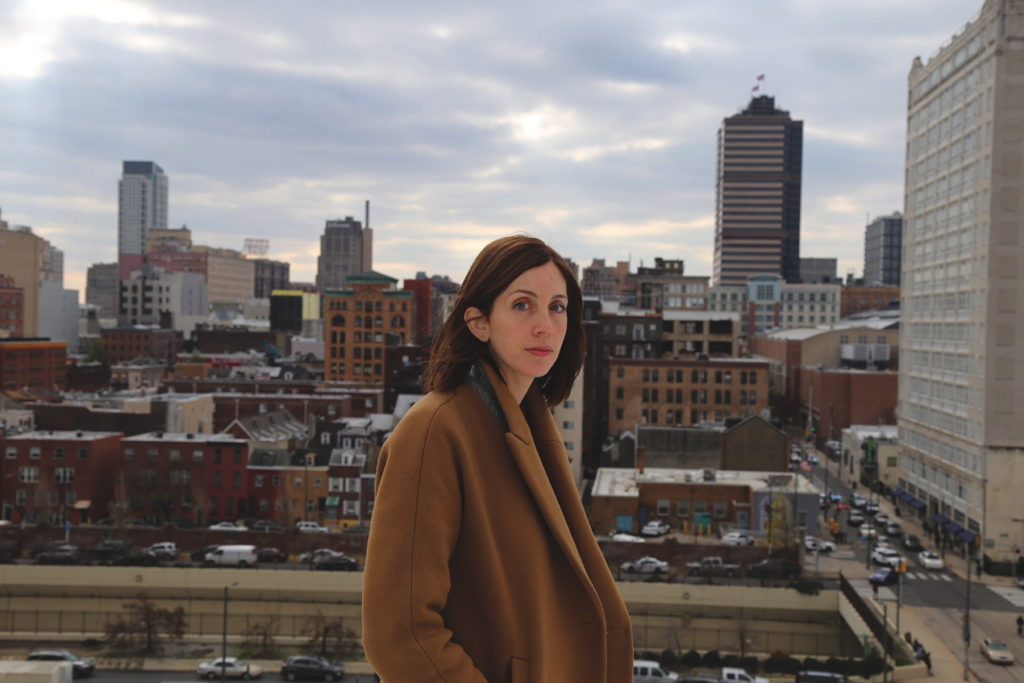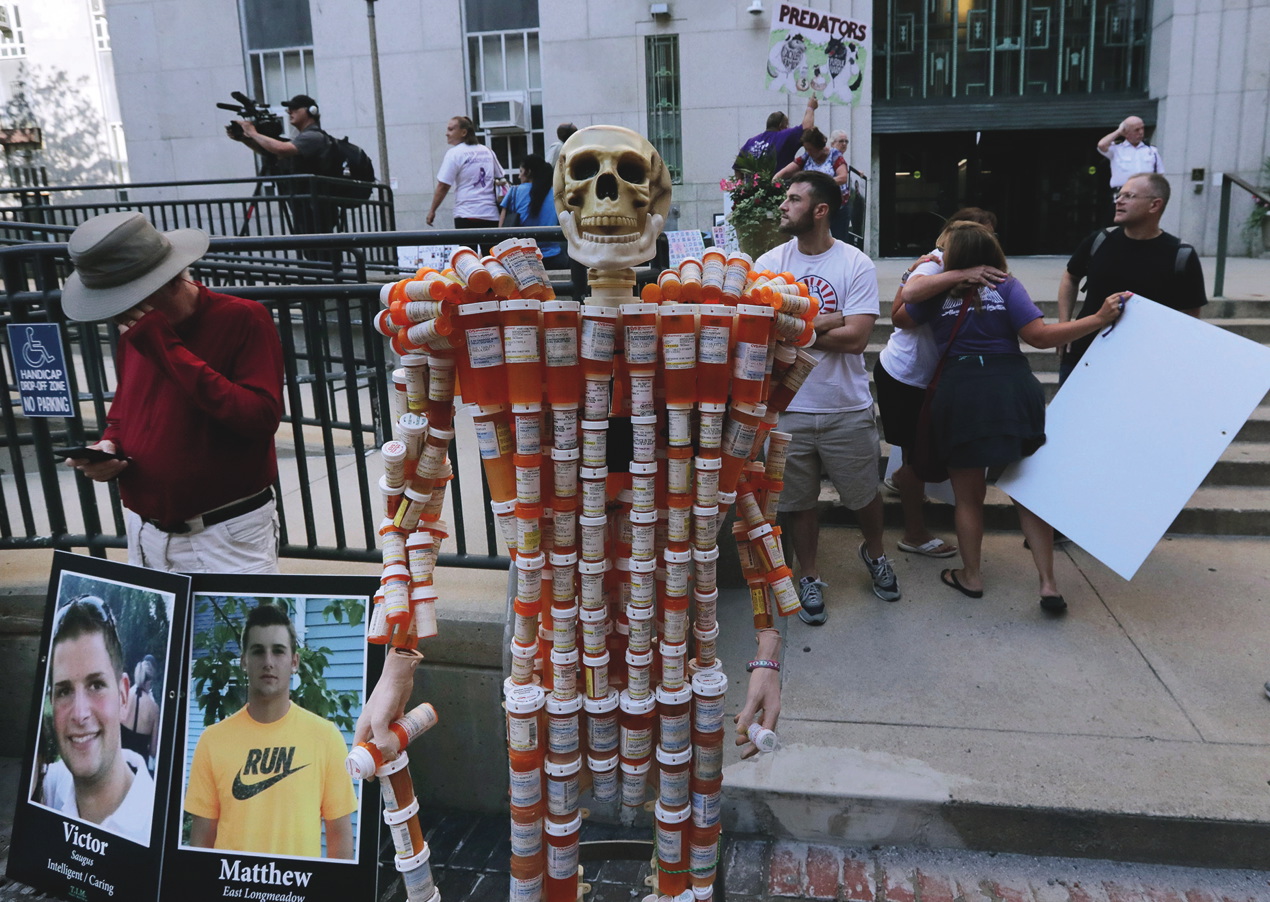A creeping dependency
In the US the opioid crisis is wrecking communities and has brought convictions for pharmaceutical executives that might lead to jail. With usage climbing steadily how far behind might the UK be?
Katie Bedford was 16 when she was first prescribed opioids: morphine in hospital and codeine upon discharge. She then took dozens of painkillers a day for 10 years.
“I could get 100 tablets a week without setting foot in the surgery by ordering repeat prescriptions online,” she says. “I never even got a phone call to ask what they were for.”
That first dose of morphine was administered intravenously while Bedford was in agony with a burst ovarian cyst.
“It felt amazing. The walls seemed to turn pink,” she recalls. “I suffer from endometriosis but was misdiagnosed for years. They kept prescribing me co-codamol though and if a doctor says take something, you do it.”
In reality, she was a mess. After losing her dad to cancer when she was 20, her dependency worsened. She would top up her prescription with over-the-counter codeine with anti-inflammatories, which can cause stomach problems – and at her worst was taking 30 tablets a day. She performed poorly at work and was regularly sick, lethargic and moody.
Bedford, 27, is lucky to live close to one of only two free specialist services for patients like her. The Bridge Project, in Bradford, runs mainstream drug treatment programmes and boasts a prescription medication service. Patients are often referred by GPs and sessions take place in local surgeries.
Recovery co-ordinator Michael Ritchie helps people taper off the drugs safely while unpicking the psychological issues that often compound their dependency. His 70-strong caseload has more women on it than men and ranges in age from 20 to 80.
Bedford’s surgery told her to call the Frank helpline, which suggested a rehab centre that cost £2,500 a week. Eventually she learned about the Bridge Project.
She began her programme in 2018 and was opioid-free within two months. The emotional issues were harder to tackle though and she still speaks to Ritchie.
He says: “These people have been prescribed these drugs for a legitimate reason but found they also helped them cope with some trauma they’d experienced. Dependence creeps up on them. They can initially be quite resistant – they think their world will collapse without the tablets. They get lost in the system because they aren’t committing crimes.”
Millions of adults in the UK are thought to live with chronic pain – defined as lasting three months or more. But there are few effective treatments available.
Opioids – which originate from the poppy plant but are now often synthetically produced – are best suited to treating acute, end of life and cancer pain. But from the 1990s, the number of patients being prescribed them for chronic pain soared – peaking at 24 million prescriptions in 2016, before dropping slightly. In 2017-18, 5.6 million adults received at least one opioid prescription, while 540,000 non-cancer patients had been on them for at least three years.
The reasons behind the rise are complex. Partly it can be attributed to an ageing population and more people living with pain. General practice is under strain – with short appointment times and patients who expect to be medicated.
But experts say opioids are being used inappropriately in many cases. In the nineties they were promoted through pharmaceutical industry-sponsored educational events, sold as the great new weapon against pain. GPs were told they were being used in pain clinics, so why not primary care too?
By the mid 2000s, concerns were being raised but as Dr Roger Knaggs, of the Royal Pharmaceutical Society and British Pain Society, puts it: “These messages are taking a long time to get through to everyone. There are so many influences which affect prescribing habits, it can be like turning a juggernaut.”
Opioids can cause a range of problems, including depression, anxiety, headaches, hyperalgesia – heightened sensitivity to pain – and overdose and death.
Dose levels are an issue, with the overdose risk rising fast as pills become stronger. While overall prescription numbers went up by 34 per cent between 1998 and 2016, researchers from the University of Oxford found that when drug strength was accounted for, the rise increased to 127 per cent.
Ritchie has seen people on the equivalent of over 1,000mg of morphine a day – a dose that would kill most people who have not been exposed to opioids, and five times what is considered to be a high dose in clinical practice.
In the US – where 130 people die from opioid overdose every day – a judge in Oklahoma last year ordered Johnson & Johnson, the maker of oxycodone and fentanyl patches, to pay the state $572 million (£457 million) for the destruction wrought by prescription opioids.

Purdue Pharma, the maker of OxyContin, and its owners, members of the Sackler family, have offered to settle more than 2,000 lawsuits against the company for $10-12 billion (£8-9.6 billion). The lawsuits – brought by states, cities and counties – allege they are responsible for starting and sustaining the country’s opioid crisis. Purdue Pharma has earned more than $35 billion (£28 billion) from selling Oxycontin.
Although some way off that scale of crisis, UK hospital admissions and deaths have been creeping upwards. NHS data shows almost 9,500 patients were treated for poisoning from opioids such as codeine and morphine in 2018-19 – up from 7,400 in 2012-13. The number of people admitted for heroin or opium poisoning, by comparison, was 1,850.
While heroin accounts for the largest number of opiate-related deaths – 1,336 in 2018 – opioid medications are increasingly prevalent. Figures from the Office of National Statistics show deaths from other opiates – including methadone – hit 872 that year. Codeine was linked to 169 deaths, up from 70 in 2008. Dihydrocodeine was associated with 97 deaths in 2018, up from 79, and oxycodone with 79 deaths, up from 22.
Tramadol was reclassified to a Schedule 3 controlled drug in 2014, after deaths climbed to 240 but was still linked with 220 deaths in 2018. Reclassification meant prescriptions are only valid for 28 days and automatic repeat prescriptions are banned.
The subject of dependency is under-researched – with estimates of people who may be addicted to opioids ranging from the tens of thousands to almost a million.
Despite the risks, no monitoring is currently required for patients on repeat prescriptions. Should someone need help, there is no network of specialist addiction services to which GPs or pain doctors can refer.
Unless patients live near Bradford or North East Wales – or can afford private treatment – the only support available is through mainstream drugs services. Although users are not excluded from these, stigma means they are unlikely to attend.
Patients who live in poor areas are more likely to be prescribed opioids – with GPs in the north dishing out some of the highest levels. GPs in Blackpool and St Helens prescribe more than anywhere else in England, according to research by the universities of Manchester and Nottingham. Knowsley, Barnsley, Halton and Doncaster are also among the top 10.
The National Institute for Health and Care Excellence is developing guidelines on safe prescribing and withdrawal management of medications, including opioids, and packaging will soon carry warnings about the risk of addiction.
But pain management requires more than drugs and experts say greater access to mental health support could lower prescribing levels. Last year, Public Health England published a report on prescription medication. The widespread prescribing of opioids, benzodiazepines and sleeping pills needs to change, its authors warned – adding that that GPs should instead consider social prescribing. Other recommendations included referrals to mental health teams, psychological therapies, support groups, pain clinics and addiction services.
Ritchie, a cognitive behavioural therapist, has worked with hundreds of people since his prescription drugs service launched five years ago. Tailored counselling is a key feature of recovery, alongside support with withdrawal. The service, which is largely funded by Bradford Council, is over-subscribed.
Although few in number, treatment programmes are backed by evidence. In the 2017 Drugs Strategy the government pledged to support local authorities and clinical commissioning groups so that people dependent on medicines can access suitable programmes. They provide good value for money, with every £1 spent on structured drug therapy saving local services £2.50.
The agency We Are With You – formerly Addaction – occasionally supports users of prescription medications in its clinics. It also runs an online web chat where people can log on and talk to a recovery worker.
Director of pharmacy Rachel Britton recalls a woman who had become hooked on tramadol following an operation overdosing at one of its services. She was given naloxone to reverse the overdose.
She says: “While we’d need to modify how we support people with these different dependencies a bit, in terms of the psychosocial interventions there are similarities. That’s the bit that makes the difference in drug treatment – giving people the tools to deal with psychological pain, without needing to take a pill or pick up a needle.”
In the US, several studies have shown chronic pain patients who use medical cannabis reduced their use of opioids by anywhere between 64 and 97 per cent. Another harm reduction approach is the deregulation of naloxone. Australia is currently trialling a scheme where this is being made available free of charge to users of prescription opioids, to help prevent accidental overdoses.
Britton says: “I think there’s something quite interesting here around prescription opiates. The question I would ask is are we talking to these people about naloxone? In an ideal world where we had the funding, we would absolutely be making it available. If they could go to a local pharmacy and get a supply that could work well.”
Dr Richard Cooper, a former pharmacist who is now a senior lecturer in public health at University of Sheffield, surveyed more than 800 patients from 13 GP surgeries who are on opioid prescriptions and found about one in seven participants could be classed as dependent. They experienced delays getting referred to pain clinics and for other treatments, which could reduce the reliance on pills.
“Our interviews revealed that patients were often respectful, resentful and resigned,” he says. “There were themes of resentment of medicines, respect for doctors and a resignation to pain. They felt there was no way out and had an enduring sense that their situation was not going to get better.”
Cooper would like to see more prevention – training and educating prescribers about alternatives to opioids, for example. GP surgeries could be audited to check which patients on their lists have been on opioids for long periods of time and to look at doses. This work could be done by community pharmacists, he believes, if funding
was available.
To this end, a team from Durham University has developed a toolkit to help GPs treat chronic pain safely and effectively through psychosocial interventions and reduce their reliance on painkillers.
The team has also launched an interactive website, Ten Footsteps, aimed at supporting patients to self-manage their pain and improve their quality of life. The resource looks at ways people can learn to live with their symptoms.
The initiative was developed as part of research into persistent pain and the high levels of opioid prescriptions in the North East.
The team – which is working with the highest-prescribing GP practice in County Durham – found evidence of a “pain divide” behind regional variations in data. Rather than being an issue of inappropriate prescribing, they found people in their region were more likely to experience chronic pain.
Dr Paul Chazot, associate professor in the department of biosciences, says: “Pain is the single biggest reason people see their doctor and GPs need help to deal with this. They cannot measure it and cannot treat it effectively. We need to develop primary and community care clinician confidence to manage chronic pain and safe prescribing effectively. Persistent pain cannot be fixed or cured at the moment. We need a person-centred management to help people live better lives with it.
“More needs to be done – at a national level – to support prescribers to manage people who have chronic pain, without the need to initiate opioid analgesics, perhaps using more non-pharmacological pain management strategies.”
Back in Bradford, Ritchie would agree. One of his clients, who was taking huge doses of fentanyl, can walk upright for the first time in 20 years after processing the emotions linked to being abused as a child. Another hopes to walk again after years in a wheelchair due to leg problems which were a physical manifestation of trauma.
“I see people with a lot of trauma and the mental health services they need are just not there,” he says. “We help them process what we can. I would never say there isn’t genuine physical pain but the people I work with have been given painkillers when actually some of them needed psychological support, which is hard to get.
“Some GPs are amazing at checking through their records – they can see the benefit of this work and are very proactive. It’s cost effective too, because people’s physical health gets better, their mental health improves, they aren’t taking bucketloads of medication they don’t need and they aren’t seeing their doctor for every ailment under the sun. We need more services like this across the country.”
This article has been amended to highlight the fact that only some members of the Sackler family are associated with OxyContin

It was a photo project about people experiencing homelessness and opioid addiction that first brought Liz Moore to the subject.
The author was fairly new to Philadelphia when she was invited to interview people who had been photographed for Jeffrey Stockbridge’s Kensington Blues project. Their stories captured her attention and she began returning to the dilapidated neighbourhood to run writing workshops and get to know people better.
Their experiences became the inspiration for her fourth novel, Long Bright River, which is set in Kensington and examines the US opioid crisis through the eyes of two sisters – one a police officer and the other an addict.
She says: “I felt very moved by the people I met and very concerned for them and I felt a strong emotional pull to the neighbourhood.
“My own family has a history of addiction, so there was a personal connection to the subject. Some of the clients at the women’s centre where I worked were experiencing homelessness, some were involved in substance abuse and some were facing domestic violence and poverty.
“The characters in my novel are not based on real people, but the stories of how people become addicted to opioids in the US are often similar. It usually starts with a prescription for pain medication and once that runs out it turns into buying heroin from the street. The victims of this epidemic were almost duped into addiction by pharmaceutical firms which were untruthful about the addictive potential of their medicines.”
One of the things Moore could not help but notice about Kensington – once a prosperous neighbourhood but now synonymous with drugs and dotted with abandoned buildings – was the sense of solidarity among residents. That feeling of community can be both a blessing and a curse, she says. In 2017 in Philadelphia, 1,200 people died from overdose. The following year the numbers fell but still averaged three people per day.
“Some people told me their best shot of overcoming addiction for good would be to get out of Kensington altogether,” she says. “But few have the resources to do that, and in any case that would mean leaving behind their friends and in some cases their family. There is an almost gravitational pull back to the neighbourhood and their life there over and over again, but unfortunately sticking with the same routine can lead to relapse.”

Leave a reply
Your email address will not be published.